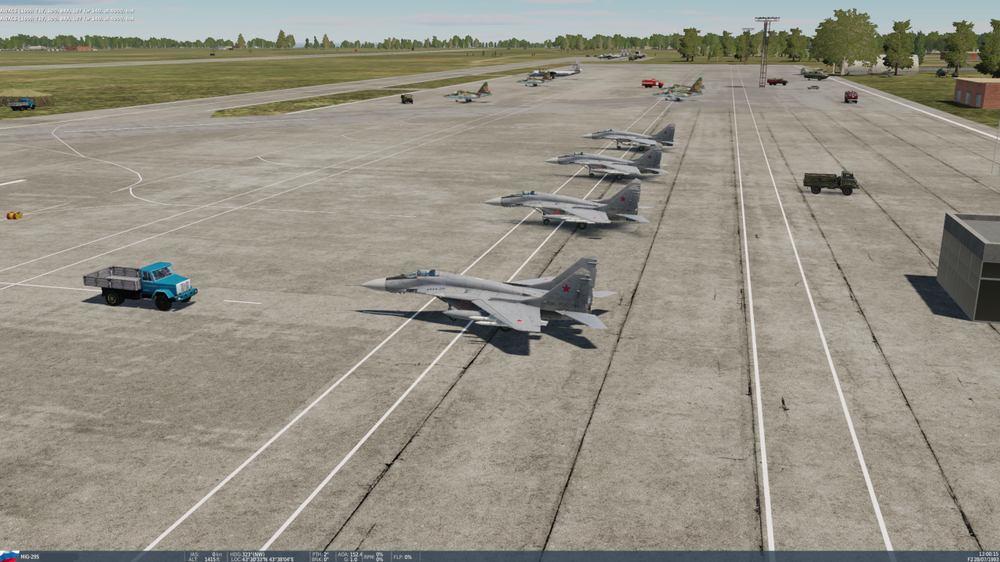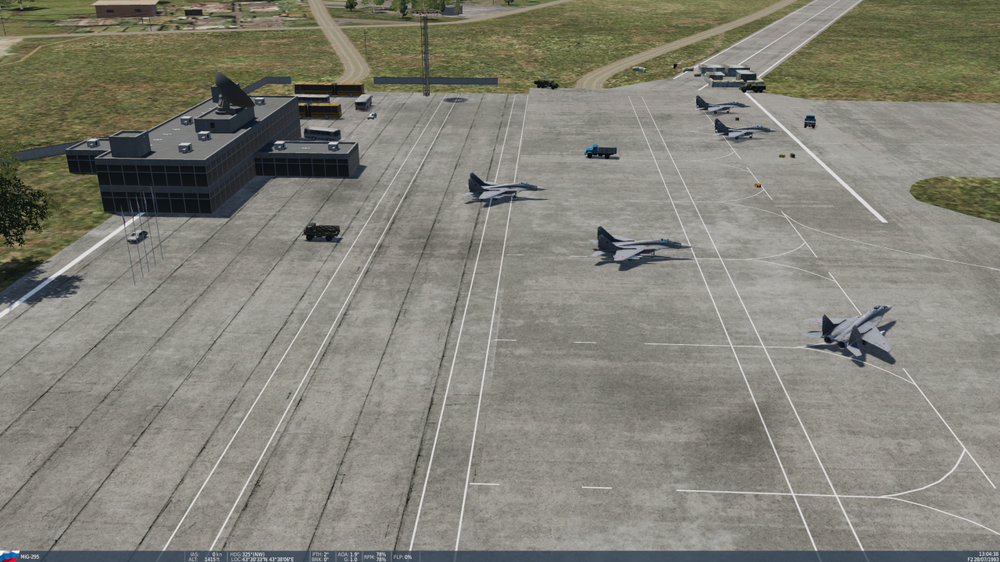

Basher54321
Members-
Posts
488 -
Joined
-
Last visited
Recent Profile Visitors
The recent visitors block is disabled and is not being shown to other users.
-
If that is VF-126 as the description says then they only operated F-16N (Small Inlet de-tuned Block 30) aggressors up to around 1994 AFAIK. One change on the F-16N was to replace the APG-68 with the APG-66. (there were some other changes). So that is probably what the 1980s APG-66 looked like in a C model. That AIR symbol in the top left hand corner is only on the old F-16 APG-66(V) and (V)1 radars that I have seen.
-
The APG-66(V)2 and 3 from the mid 1990s look like total rebuilds going by the description of changes.
-
The top diagram is from an NG sales brochure but it shows the VSR mode which is a longer range (High and Medium PRF) mode that is not in the game yet. Cannot say but looking at the second (types of aircraft & limited modes) probably the original APG-66(V) - in a 1981 congress hearing it was said that not only were they very happy with the APG-66 it was performing 20% better than their requirements specified.
-

What other modifications/variants will we get?
Basher54321 replied to DSplayer's topic in DCS: F-4E Phantom
Israel bought a batch of STARMs in the mid 1970s and used them on their F-4Es. -

Roll Input structural failure modeling is incorrect.
Basher54321 replied to =475FG= Dawger's topic in Bugs and Problems
Right - Here is where you are Dawger. You have found an old document on the Internet. You have spent a little time reading it. Unfortunately you clearly have no understanding of what is written there and that is demonstrated in your various posts - you are not even close. But then you have no knowledge of this subject so not your fault. My "opinion" as you put it is unfortunately for you more informed than you realize. There is a heck of a lot more to this however that is one can of worms I will not be opening because it will just confuse everyone even more. If you can find the original USAF specs that Northrop had to build the aircraft to that might be useful - or if you can get hold of an actual F-5E structural engineer they would be the best source - anyone else seriously wouldn't have a clue. My advice would be to pass information on without commenting on it. cheers -
Ran it around in free flight clean and for whatever reason maybe luck seems pretty good to me - in the transonic region at low alts breaking 11G - 12.5G - but at lower speeds cannot generate the Gs for this to be any concern. There is no point referencing reality when reality involves flying under 7.33G which is the max G limit clean. It sounds like DCS gamers have got used to ignoring limits and flying it like an arcade game. (Any perceived structural margin is NOT your limit!!) Relax the stick / changing the pitch curves might help. Maybe a G indicator option on screen all the time might help. The T-38 was built to an initial 15000 hour lifetime and 7.33G at 50% fuel and has clearly been used as intended if it is still in use today - also going through various structure upgrade programs. https://www.af.mil/News/Article-Display/Article/612443/maintainers-extend-life-of-t-38-talon/. The F-5E is a different aircraft with an initial 8000 hour lifetime and built to 7.33G at 100% internal fuel.
-

Wings breaking off in AV8B and F14 realistic?
Basher54321 replied to truebrit's topic in General Bugs
Simplistically if max design G was 7.5 then all bets would be off over 11.3G and anything could structurally fail (on a new aircraft) But if anyone can get an F-14 structural engineer to confirm the design (and not Mike Ciminera who doesn't appear to know) -

Wings breaking off in AV8B and F14 realistic?
Basher54321 replied to truebrit's topic in General Bugs
No they don't need to test to breaking point. Ultimately the customer (eg USN/USAF) writes a spec that includes all the required limits for the desired aircraft including lifetime and intended usage etc. If say they specify 8G clean at X weight then that is what the aircraft will be built to. However there is a standard safety margin that means a part must not break at 150% over the required load limit. So simplistic example - say I want my plane to be 8G then parts will be stress tested to 150% of that (12G). My take from the 777 video is you can hear them cheer when the part hits 150% - but the part fails however at only 4% past this that is why you got to see it break. Often they never see the part break because it only needs to not break up to 150% - so they don't continue stressing it because 150% meets the requirement. This means that if someone pulls say 12G+ in your 8G jet you would expect loss of aircraft but there is no simple answer as to what breaks because they usually don't know - These things are on a time and cost budget of course. If you pull say 10G well it might be okay on one occasion but another time someone pulls it at a different weight they can put the jet out of action when you need it - again there is no simple answer. All aircraft are designed and built to specification - and that is the entire aircraft not just the engine or whatever - for example F-14/15 might be able to go through their design limit of 800kts but nothing on the jet is certified to do it so a pilot going over the limits is usually nothing more than a test pilot. Source is an ex structural engineer who worked on some very iconic USAF/USN Jet fighters. -
Cant say - according to someone who flew the MiG-29G for two years on exchange they had the full up Soviet radar for example. (East Germany being on the front might have been an exception) The engines were not detuned as such - there is a switch that the ground crew can set to put the engines in one of three modes (also in the flight manual). They generally had them on the lower power setting to increase lifetime but obviously whacked them up to full power for deployments to do DACT etc.
-

Is taking 3 fuel tanks on a F-16 a good idea?
Basher54321 replied to Strider1_Trigger's topic in DCS: F-16C Viper
What he is saying is that sometime probably after 1992 a number of US F-16s were made Sparrow capable based on his experience with them on his USAF squadron. AMRAAM was FOC in mid 1992 - an F-16D shot down an Iraqi MiG-25PDS later that year with an AIM-120A. NYANG and SCANG flew Block 10s during Desert Storm and very successfully too. -
The latest patch has broken this on Open Beta 2.7.2.7910 for me Nalchick now has a load of objects on the taxiways. The MiG 29 start positions look wrong (closest is player): MiGs ran into objects on attempt one. Reset Campaign and wingman would not budge. Tried mission 2 and wingmen moved a bit and then were as stumped as a self driving car as presumably they couldn't comprehend any of these strange objects.
-
That was never a thing - there are various tactical and operational manuals on the AIM-9B including an entire paper written by John Boyd on its real world limitations when using it. There are also a ton of declass firings of the thing that make no mention and Robin Olds would have ripped it apart the way he did the AIM-4 as being not FFP. Two of the things that could cause a delay in getting the correct signal: 1. Damage to the missile from vibration/weather/rain /hail. 2. Humidity levels in the atmosphere. IR missiles are clear weather missiles only - and these two ideally needed to be fired with no background IR radiation such as clouds, the sun or the ground / water. Then pray the missile actually doesn't hang and doesn't just fly off into the Ether anyway. The AIM-9B/R-3S both used by Israel who were of the opinion the R-3S was overall comparable to the AIM-9B. Firing these missiles should not be easy you had to work at it - the first 14 combat firings of the R-3S for the VPAF all missed. Check out the Osprey books by István Toperczer based on data from the VPAFs war records and there is also a set on the USAF jets over Nam all based on declass stuff like Red Baron etc. It is understandable why you would make these missiles gamey for a game because the players want their missiles to hit.
-

[LATER IN EARLY ACCESS] Viper roadmap - No AG radar?
Basher54321 replied to jetkid's topic in Wish List
Well said - thanks for the input DJ! -

BF-109K-4 "Jagdflieger" Campaign Issues
Basher54321 replied to Xoho's topic in Bf 109 K-4 Jagdflieger Campaign
This campaign was very good - probably the best - I had to Google map Beny-Sur-Mer perhaps I missed something. Same as the others 2.5.6 has definitely added bloat in there - in the past the bloat has often been there to stay in some games. Hopefully this is down to a bug and not just down to some lighting effects nobody needed - or at least nothing should come above performance to be causing issues like this at the higher end. -
Hello Yes you are basically correct - however what I am primarily referring to here is a CAT III loading that is more likely to cause actual structural problems when going past the AG stores manual G limit of 5.5G etc for example. The F-16 originally didn't have a CAT switch at all and there was even a CAT II loading at one point (not a physical switch) - and yes plenty of pilots claim to have kept flying CAT 1 regardless - but there are some good reasons why it can be a bad idea.





